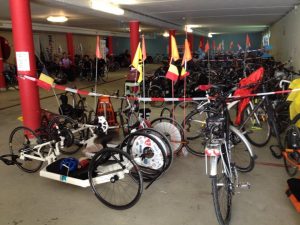Handbike

De deelnemers nemen zelf een handbike mee naar Oostenrijk. De teamdeelnemers kunnen in het revalidatiecentrum advies vragen over de aanschaf, aanvraag of de leenmogelijkheden van een handbike. Kijk ook eens naar de mogelijkheden van Uniek Sporten. En op www.handbiken.nl kan je een bericht plaatsen als je een handbike zoekt of er één in de aanbieding hebt.
Geschikte handbike
Een geschikte handbike is een vastframe handbike met zit- of ligpositie, of een kniezitter. Je hebt een extreem bergverzet nodig omdat je vooral moet stijgen. Het is nuttig om hierover informatie in te winnen bij experts. Dat kan ook via technisch@handbikebattle.nl.
Testen op een helling
We adviseren om de handbike uit te proberen op een klim van 12%. Dat kan op een loopband in een revalidatiecentrum. Lukt dat niet, dan zijn er op de Keutenberg of Cauberg ook uitdagende stukken om het hellingspercentage uit te proberen.
Laat je handbike controleren!

Het is belangrijk om voor vertrek naar Oostenrijk de handbike te laten controleren door de technische commissie (Frontline Handbikes). Je bent er dan zeker van dat de handbike in orde is. En je helpt Frontline om een volledig overzicht te hebben van de handbikes die meedoen (merk en type).
Frontline neemt contact op met de contactpersoon van de teams om een controleafspraak in te plannen. Ook voor individuele deelnemers is controle belangrijk. Als je al eerder meedeed aan de HandbikeBattle in een team van een revalidatiecentrum, kun je met dat team contact opnemen om aan te sluiten bij het controlemoment van dat team. En anders kan je ook een individuele afspraak maken via technisch@handbikebattle.nl.
Tips
- Zorg dat je al flink wat kilometers hebt afgelegd voordat je begint aan de HandbikeBattle.
- Ga niet rijden met een handbike die je net hebt want dit kan allerlei ongemakken geven tijdens het evenement.
- Zorg dat Frontline je handbike heeft gecontroleerd.
Reserveonderdelen
- Frontline neemt veel reserveonderdelen mee. Neem zelf in elk geval een reservebinnenband mee. Dan ben je er zeker van dat de juiste band op voorraad is als je een lekke band hebt.
- Gebruik je elektronische versnellingsschakelaars (shifters), zorg dan dat je een extra accu, elektronische kabels en eventueel een computer interface meeneemt. Het kan namelijk zijn dat Frontline niet alle onderdelen bij zich heeft.
Versnellingen
Het is belangrijk om de juiste versnellingen te monteren op je handbike. We noemen dit ‘verzet’. Het verwijst naar de verhouding tussen de kettingbladen op het crankstel en de tandwielen van de cassette. Bij het klimmen is een kleine versnelling (klein of licht verzet) van belang.
Monteer op het crankstel het kleinste blad van 22 of 24 tanden en op het wiel een cassette waarvan het grootste tandwiel 42 tanden of 46 tanden is (11-42) of (11-46). Laat dit eventueel controleren bij je eigen rijwielzaak voordat Frontline je handbike checkt.
Technische eisen handbike
1. Versnellingen. De versnellingen moeten allemaal te bedienen zijn. Controleer of alle tandwielen op de cassette bereikbaar zijn voor de ketting. Zeker de kleinste versnelling! Gaat het schakelen zwaar of met een vertraging, laat dan je kabels controleren.
2. Remmen. De remmen moeten goed werken; ook de parkeerrem. Het bedienen van de rem moet met geringe knijpkracht kunnen. Kijk ook naar de remblokken: zijn ze (bijna) versleten, vervang ze dan! Controleer of de remblokken juist zijn afgesteld (niet tegen de velg of band lopen).
3. Kabels. Zorg dat de boogkabels van het handvat naar het frame vrij zijn van knikken en beschadigingen.
Als je de buiten- of binnenkabel wilt vervangen, doe dat dan ruim voor de HandbikeBattle. Er staan namelijk rek- en duwkrachten op de buitenkabel en de binnenkabel. En daardoor is na-stellen in het begin nodig.
4. Wielen. De wielen moeten recht zijn en vrijlopen van de rem. Als de achterwielen schuin staan (in Camber) dan is het belangrijk dat deze goed uitgelijnd zijn, want ’toe-spoor’of ‘uit-spoor’ heeft ongewenst remmen tot gevolg.
5. Bandenspanning. De bandenspanning moet 5-7 Bar zijn (afhankelijk van de band). De handbike rijdt daardoor lichter en de banden slijten minder snel.
6. Veiligheid. Vanwege de veiligheid is een vlag verplicht. En we adviseren een achterbumper.
Contact: technisch@handbikebattle.nl
